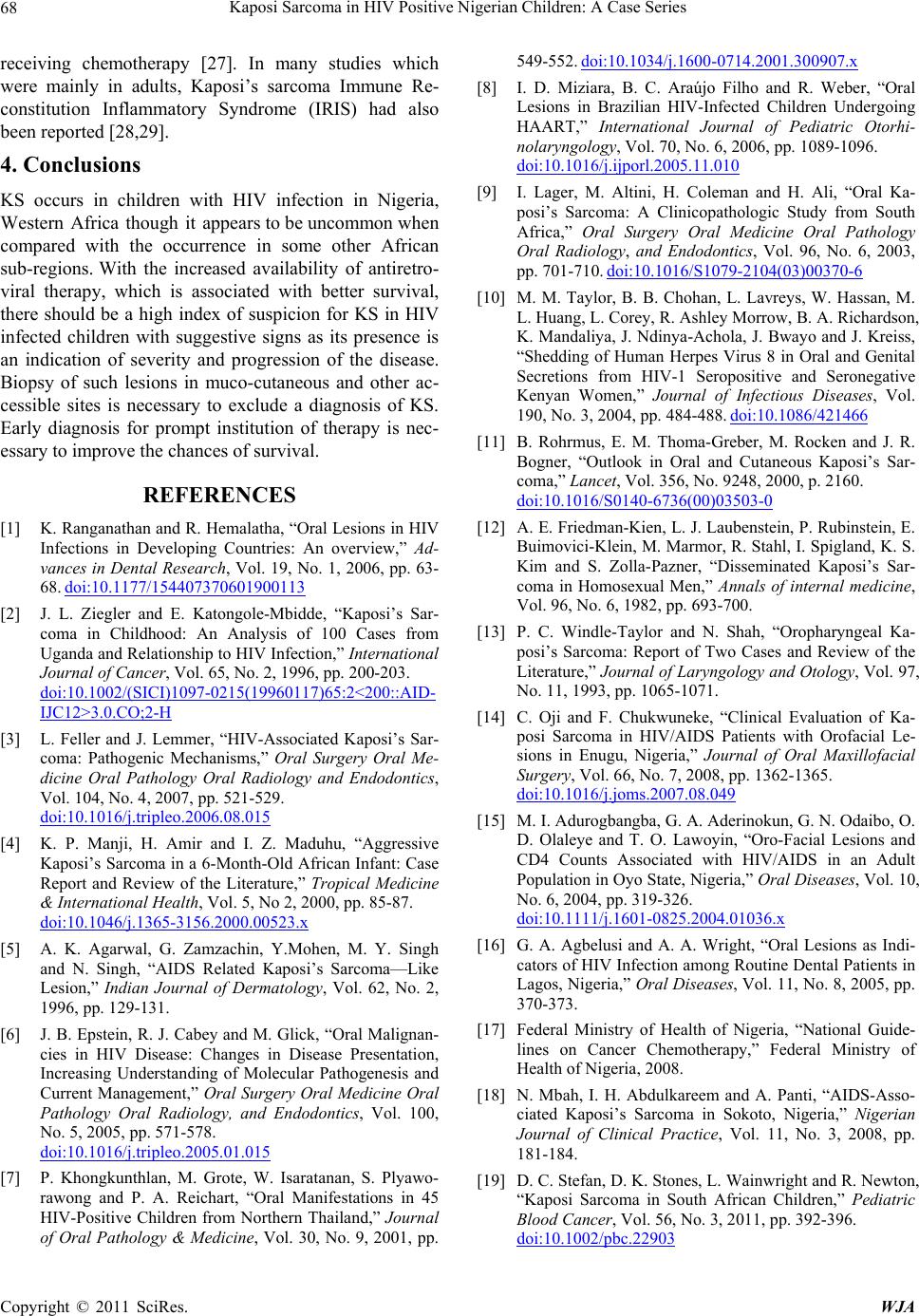
Kaposi Sarcoma in HIV Positive Nigerian Children: A Case Series
68
receiving chemotherapy [27]. In many studies which
were mainly in adults, Kaposi’s sarcoma Immune Re-
constitution Inflammatory Syndrome (IRIS) had also
been reported [28,29].
4. Conclusions
KS occurs in children with HIV infection in Nigeria,
Western Africa though it appears to be uncommon when
compared with the occurrence in some other African
sub-regions. With the increased availability of antiretro-
viral therapy, which is associated with better survival,
there should be a high index of suspicion for KS in HIV
infected children with suggestive signs as its presence is
an indication of severity and progression of the disease.
Biopsy of such lesions in muco-cutaneous and other ac-
cessible sites is necessary to exclude a diagnosis of KS.
Early diagnosis for prompt institution of therapy is nec-
essary to improve the chances of survival.
REFERENCES
[1] K. Ranganathan and R. Hemalatha, “Oral Lesions in HIV
Infections in Developing Countries: An overview,” Ad-
vances in Dental Research, Vol. 19, No. 1, 2006, pp. 63-
68. doi:10.1177/154407370601900113
[2] J. L. Ziegler and E. Katongole-Mbidde, “Kaposi’s Sar-
coma in Childhood: An Analysis of 100 Cases from
Uganda and Relationship to HIV Infection,” International
Journal of Cancer, Vol. 65, No. 2, 1996, pp. 200-203.
doi:10.1002/(SICI)1097-0215(19960117)65:2<200::AID-
IJC12>3.0.CO;2-H
[3] L. Feller and J. Lemmer, “HIV-Associated Kaposi’s Sar-
coma: Pathogenic Mechanisms,” Oral Surgery Oral Me-
dicine Oral Pathology Oral Radiology and Endodontics,
Vol. 104, No. 4, 2007, pp. 521-529.
doi:10.1016/j.tripleo.2006.08.015
[4] K. P. Manji, H. Amir and I. Z. Maduhu, “Aggressive
Kaposi’s Sarcoma in a 6-Month-Old African Infant: Case
Report and Review of the Literature,” Tropical Medicine
& International Health, Vol. 5, No 2, 2000, pp. 85-87.
doi:10.1046/j.1365-3156.2000.00523.x
[5] A. K. Agarwal, G. Zamzachin, Y.Mohen, M. Y. Singh
and N. Singh, “AIDS Related Kaposi’s Sarcoma—Like
Lesion,” Indian Journal of Dermatology, Vol. 62, No. 2,
1996, pp. 129-131.
[6] J. B. Epstein, R. J. Cabey and M. Glick, “Oral Malignan-
cies in HIV Disease: Changes in Disease Presentation,
Increasing Understanding of Molecular Pathogenesis and
Current Management,” Oral Surgery Oral Medicine Oral
Pathology Oral Radiology, and Endodontics, Vol. 100,
No. 5, 2005, pp. 571-578.
doi:10.1016/j.tripleo.2005.01.015
[7] P. Khongkunthlan, M. Grote, W. Isaratanan, S. Plyawo-
rawong and P. A. Reichart, “Oral Manifestations in 45
HIV-Positive Children from Northern Thailand,” Journal
of Oral Pathology & Medicine, Vol. 30, No. 9, 2001, pp.
549-552. doi:10.1034/j.1600-0714.2001.300907.x
[8] I. D. Miziara, B. C. Araújo Filho and R. Weber, “Oral
Lesions in Brazilian HIV-Infected Children Undergoing
HAART,” International Journal of Pediatric Otorhi-
nolaryngology, Vol. 70, No. 6, 2006, pp. 1089-1096.
doi:10.1016/j.ijporl.2005.11.010
[9] I. Lager, M. Altini, H. Coleman and H. Ali, “Oral Ka-
posi’s Sarcoma: A Clinicopathologic Study from South
Africa,” Oral Surgery Oral Medicine Oral Pathology
Oral Radiology, and Endodontics, Vol. 96, No. 6, 2003,
pp. 701-710. doi:10.1016/S1079-2104(03)00370-6
[10] M. M. Taylor, B. B. Chohan, L. Lavreys, W. Hassan, M.
L. Huang, L. Corey, R. Ashley Morrow, B. A. Richardson,
K. Mandaliya, J. Ndinya -Achola, J. Bwayo and J. Kreiss,
“Shedding of Human Herpes Virus 8 in Oral and Genital
Secretions from HIV-1 Seropositive and Seronegative
Kenyan Women,” Journal of Infectious Diseases, Vol.
190, No. 3, 2004, pp. 484-488. doi:10.1086/421466
[11] B. Rohrmus, E. M. Thoma-Greber, M. Rocken and J. R.
Bogner, “Outlook in Oral and Cutaneous Kaposi’s Sar-
coma,” Lancet, Vol. 356, No. 9248, 2000, p. 2160.
doi:10.1016/S0140-6736(00)03503-0
[12] A. E. Friedman-Kien, L. J. Laubenstein, P. Rubinstein, E.
Buimovici-Klein, M. Marmor, R. Stahl, I. Spigland, K. S.
Kim and S. Zolla-Pazner, “Disseminated Kaposi’s Sar-
coma in Homosexual Men,” Annals of internal medicine,
Vol. 96, No. 6, 1982, pp. 693-700.
[13] P. C. Windle-Taylor and N. Shah, “Oropharyngeal Ka-
posi’s Sarcoma: Report of Two Cases and Review of the
Literature,” Journal of Laryngology and Otology, Vol. 97,
No. 11, 1993, pp. 1065-1071.
[14] C. Oji and F. Chukwuneke, “Clinical Evaluation of Ka-
posi Sarcoma in HIV/AIDS Patients with Orofacial Le-
sions in Enugu, Nigeria,” Journal of Oral Maxillofacial
Surgery, Vol. 66, No. 7, 2008, pp. 1362-1365.
doi:10.1016/j.joms.2007.08.049
[15] M. I. Adurogbangba, G. A. Aderinokun, G. N. Odaibo, O.
D. Olaleye and T. O. Lawoyin, “Oro-Facial Lesions and
CD4 Counts Associated with HIV/AIDS in an Adult
Population in Oyo State, Nigeria,” Oral Diseases, Vol. 10,
No. 6, 2004, pp. 319-326.
doi:10.1111/j.1601-0825.2004.01036.x
[16] G. A. Agbelusi and A. A. Wright, “Oral Lesions as Indi-
cators of HIV Infection among Routine Dental Patients in
Lagos, Nigeria,” Oral Diseases, Vol. 11, No. 8, 2005, pp.
370-373.
[17] Federal Ministry of Health of Nigeria, “National Guide-
lines on Cancer Chemotherapy,” Federal Ministry of
Health of Nigeria, 2008.
[18] N. Mbah, I. H. Abdulkareem and A. Panti, “AIDS-Asso-
ciated Kaposi’s Sarcoma in Sokoto, Nigeria,” Nigerian
Journal of Clinical Practice, Vol. 11, No. 3, 2008, pp.
181-184.
[19] D. C. Stefan, D. K. Stones, L. Wainwright and R. Newton,
“Kaposi Sarcoma in South African Children,” Pediatric
Blood Cancer, Vol. 56, No. 3, 2011, pp. 392-396.
doi:10.1002/pbc.22903
Copyright © 2011 SciRes. WJA